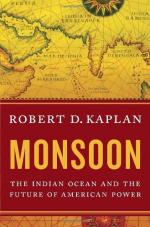|
This section contains 1,035 words (approx. 4 pages at 300 words per page) |

|
Awind in low-latitude climates that seasonally changes direction between winter and summer is called a monsoon, and is a typical example of seasonal winds. Monsoons usually blow from the land in winter (called the dry phase, because it carries cool, dry air), and to the land in summer (called the wet phase, because it carries warm, moist air), causing a drastic change in the precipitation and temperature patterns of the area.
The word "monsoon" originates from the Arabic mauzim, meaning season. It was first used to depict the winds in the Arabian Sea, but later it was extended for seasonally changing wind systems all over the world. The main reason for monsoons is the difference in the heating of land and water surfaces, which results in land-ocean pressure differences. On a small scale, heat is transferred by land-sea breezes, to maintain the energy balance between...
|
This section contains 1,035 words (approx. 4 pages at 300 words per page) |

|


